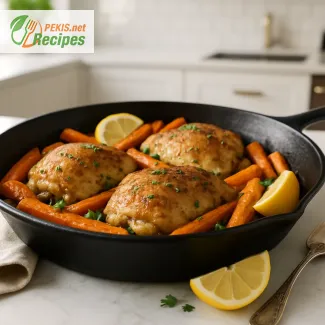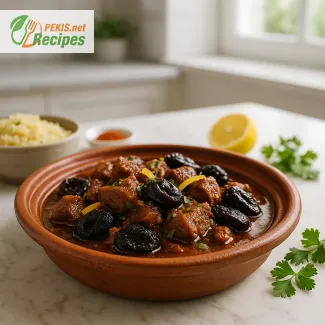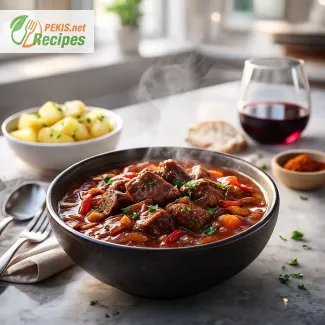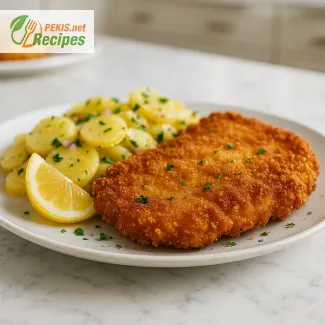The Perfect Sous Vide Ribs Finished With a Crispy Crust for Tender Flavor deliver ultra-tender meat slowly cooked to perfection, then transformed with a dramatic golden sear that crackles at every bite. A blend of smoked paprika, garlic, and brown sugar melts into the ribs, creating rich depth and a touch of sweetness rooted in slow-fire cooking traditions.
A small trick learned from countless slow-cooking sessions: letting the ribs rest a minute after searing makes the crust even crispier while keeping the center unbelievably tender. The balance of slow sous vide cooking and a fierce final heat gives this dish its signature melt-away texture and deep, savory aroma.
PEKIS – professional chef and recipe developer with more than 25 years of experience in cooking and baking, specializing in European and international cuisine.
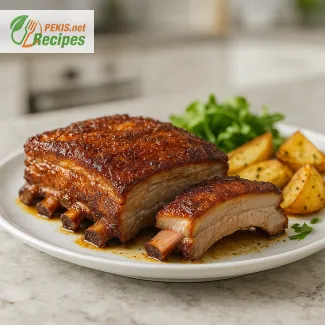
Slow-Cooked Rib Perfection With a Final Crispy Sear
Discover the deep tenderness of sous vide ribs elevated with a golden crust
The moment the steam escapes from the sealed bag and the aroma of slow-cooked ribs hits the air, there’s a pull-you-in warmth that feels almost primal. The meat is impossibly tender, giving way with the slightest pressure, yet still holding that satisfying structure you expect from a perfectly treated cut. When the ribs touch the blazing hot pan or grill at the end, the transformation becomes dramatic — the exterior turns crisp, the edges bubble, and a deep, golden-brown crust forms that crackles lightly under your fingertips. It’s the kind of texture contrast that makes every bite feel like a reward.
This style of preparation has roots in modern precision cooking, but the soul of it mirrors old slow-fire traditions where patience was the backbone of great flavor. The sous vide technique preserves every drop of moisture and intensifies the natural richness of the ribs. The finishing sear creates that signature caramelized crust reminiscent of classic barbecue, but more controlled and evenly developed. You get the nostalgia of slow fire cooking, combined with the reliability of steady low-temperature tenderness.
The seasoning plays its own important role — salt opens the fibers, garlic and pepper build gentle heat, and any sweet or smoky elements cling to the meat during the final sear, creating layers of charred sweetness and savory depth. Fat slowly renders during the long bath, turning buttery soft, making the ribs feel indulgent but balanced. Every element supports the next, resulting in a dish that feels both rustic and elevated.
Origins and evolution of sous vide rib cooking
While sous vide began in fine-dining kitchens, ribs quickly became one of the standout cuts that benefited from this method. Traditionally, ribs required hours of careful oven or smoker management. Sous vide offered chefs a way to maintain moisture consistently, unlocking ultra-tender results without losing texture. Finishing with a fierce sear pays homage to smoky barbecue traditions, merging precision cooking and fire-kissed flavor into one harmonious technique.
Ingredient influence and flavor-building
- Slow cooking preserves collagen, turning it into a silky, mouth-coating richness.
- Seasonings penetrate deeper due to extended time in the sealed environment.
- A short blast of high heat creates the signature crispy exterior that contrasts beautifully with the soft interior.
- Marinades become more concentrated and aromatic, especially when herbs and spices release oils gradually.
- Sweet glazes or rubs caramelize rapidly during searing, amplifying deep roasted notes.
During the cooking journey, some dishes pair wonderfully as complementary sides. For a crispy counterpart to the tender ribs, there’s also a recipe available for Perfect Pan-Fried Potatoes with Onion – Boiled First for Extra Flavor, which mirrors the same comfort-forward essence.
Why you’ll love this method
- Deep, consistent tenderness from edge to bone
- A crispy crust you control down to the second
- Flexibility in seasonings — classic, smoky, spicy, or sweet
- Reliable results every time
- Ideal for meal prep or cooking ahead
- Combines precision with rustic appeal
- Perfect for impressive dinners without stress
Creative variations
- Finish with a maple-smoked glaze for sweet depth.
- Brush with spicy honey for sticky heat.
- Add a garlic-herb butter baste during the final sear.
- Use coffee-based rubs for earthy, bold caramelization.
- Try Asian-inspired soy, ginger, and sesame flavors for a glossy finish.
For a more indulgent side that leans creamy and comforting, the pairing works beautifully with The best potato gratin, which adds richness without overpowering the flavor of the ribs.
Storage and make-ahead guidance
These ribs handle advance preparation extremely well. After cooking sous vide, they can be chilled directly in their sealed bag and kept refrigerated for a couple of days. The final sear should happen just before serving to retain that fresh, crisp edge. If preparing ahead for gatherings, this method ensures the meat remains juicy, flavorful, and ready to finish in minutes without any loss of quality.
Flavor-building elements and culinary entities
This dish brings together a synergy of slow rendered fat, aromatic herbs, controlled heat, and Maillard browning. Elements like garlic, pepper, smoked paprika, herbs, brown sugar, and sea salt each contribute their own character. The sous vide method preserves the purity of these flavors, while the final sear intensifies the roasted, smoky notes that make the dish feel complete.
- Pat the pork ribs dry and remove the membrane from the bone side for a more tender result.
- Mix salt, pepper, garlic powder, smoked paprika, and brown sugar. Rub this mixture evenly over the ribs, coating all sides.
- Place the ribs into a vacuum-sealed bag or a heavy-duty zip bag using the water displacement method.
- Heat the sous vide water bath to 74°C (165°F). Submerge the sealed ribs and cook for 12–13 hours until exceptionally tender.
- When done, remove the ribs from the bag and gently pat dry to ensure a crisp finish during searing.
- Heat olive oil in a pan over high heat or preheat a grill. Sear the ribs for 1–2 minutes per side until a crispy, golden crust forms.
- Brush with BBQ sauce and allow it to caramelize briefly on the heat.
- Slice between the bones and serve immediately.
FAQ questionHow long should sous vide ribs cook for the best texture?
For most pork ribs, 12–13 hours at 74°C (165°F) gives the best balance of tenderness and structure. The long time allows collagen to break down into gelatin, making the meat silky and juicy, but still firm enough to slice. Shorter times can leave the ribs a bit chewy, while much longer can make them overly soft and mushy.
FAQ questionShould ribs be seasoned before or after sous vide cooking?
Ribs should be fully seasoned before going into the sous vide bag. Salt, pepper, garlic, smoked paprika and a touch of sugar have time to penetrate deep into the meat, building flavor from the inside out. After cooking, only adjust with a little extra seasoning or glaze if needed, but the main flavor work is done before sealing.
FAQ questionWhy do sous vide ribs still need a final sear?
Sous vide creates perfect tenderness, but it doesn’t naturally develop a crust. The final sear in a hot pan or on the grill triggers the Maillard reaction, which adds a deep brown color, light crispness and roasted flavors. That contrast between the crispy exterior and soft interior is what makes this style of ribs stand out.
FAQ questionCan sous vide ribs be made ahead for guests?
Yes, this method is ideal for make-ahead entertaining. Cook the ribs sous vide, chill them in their bag in the fridge, and then reheat quickly in the water bath before guests arrive. A short, intense sear just before serving brings back the freshly cooked aroma and keeps the crust crisp without drying out the meat.
FAQ questionWhat’s the best way to get a really crispy crust after sous vide?
Drying the ribs very well after removing them from the bag is essential. Pat them thoroughly with paper towels, then sear in a pan with a thin layer of hot oil or on a very hot grill. Avoid overcrowding, don’t move them too soon, and let each side deeply brown before turning. A quick brush of sauce at the end can caramelize into a sticky, crispy glaze.
FAQ questionWhich sides go best with sous vide ribs finished in a pan or on the grill?
Rich, savory ribs pair beautifully with crispy potato dishes and fresh or tangy sides. Options like pan-fried potatoes, potato gratin, simple coleslaw, grilled vegetables or a sharp green salad help cut through the richness. The goal is to balance the fatty, smoky depth of the ribs with something crunchy, creamy or refreshing on the plate.
Slow-cooked ribs develop a depth of flavor that feels both familiar and elevated, and finishing them with a fierce sear brings out a crispy, caramelized crust that enhances every bite. The balance of tenderness and crunch makes this method stand out, especially when the seasoning blends into the meat during the long sous vide bath.
The slow, steady cooking transforms tough fibers into soft, juicy layers, giving the ribs a melt-in-your-mouth feel while still holding their shape. That final touch of heat adds complexity, boosting the smoky sweetness of the spices and creating a texture contrast that feels truly satisfying.
This approach also offers consistency, ensuring the ribs come out equally tender each time. The ability to prepare them ahead makes the process flexible and ideal for gatherings, weeknight dinners or moments when precision matters. The method respects both flavor and technique, resulting in deep, rich aromas and a finish that feels polished yet comforting.
Pairing these ribs with sides that add freshness or crunch creates a complete plate with balance and character. Whether served with something creamy, crisp or tangy, the ribs stay center stage thanks to their slow-cooked richness and perfectly browned exterior.
Allergens present in the recipe:
- None: This recipe contains no major allergens.
- Gluten: Not present.
How to remove allergens and gluten:
- Use a gluten-free BBQ sauce if needed.
- Choose spice blends verified to contain no additives or traces of allergens.
- Iron (mg): 2.7 – supports oxygen transport
- Zinc (mg): 5.4 – contributes to immune function
- Potassium (mg): 420 – supports normal muscle function
- Vitamin B12 (µg): 1.8 – essential for nerve health
- Vitamin B6 (mg): 0.6 – supports metabolism and energy release
- Paprika antioxidants (mg): 2.1 – contributes to anti-inflammatory effects
- Garlic compounds (mg): 1.4 – supports immune response
- Pepper polyphenols (mg): 0.9 – help reduce oxidative stress
